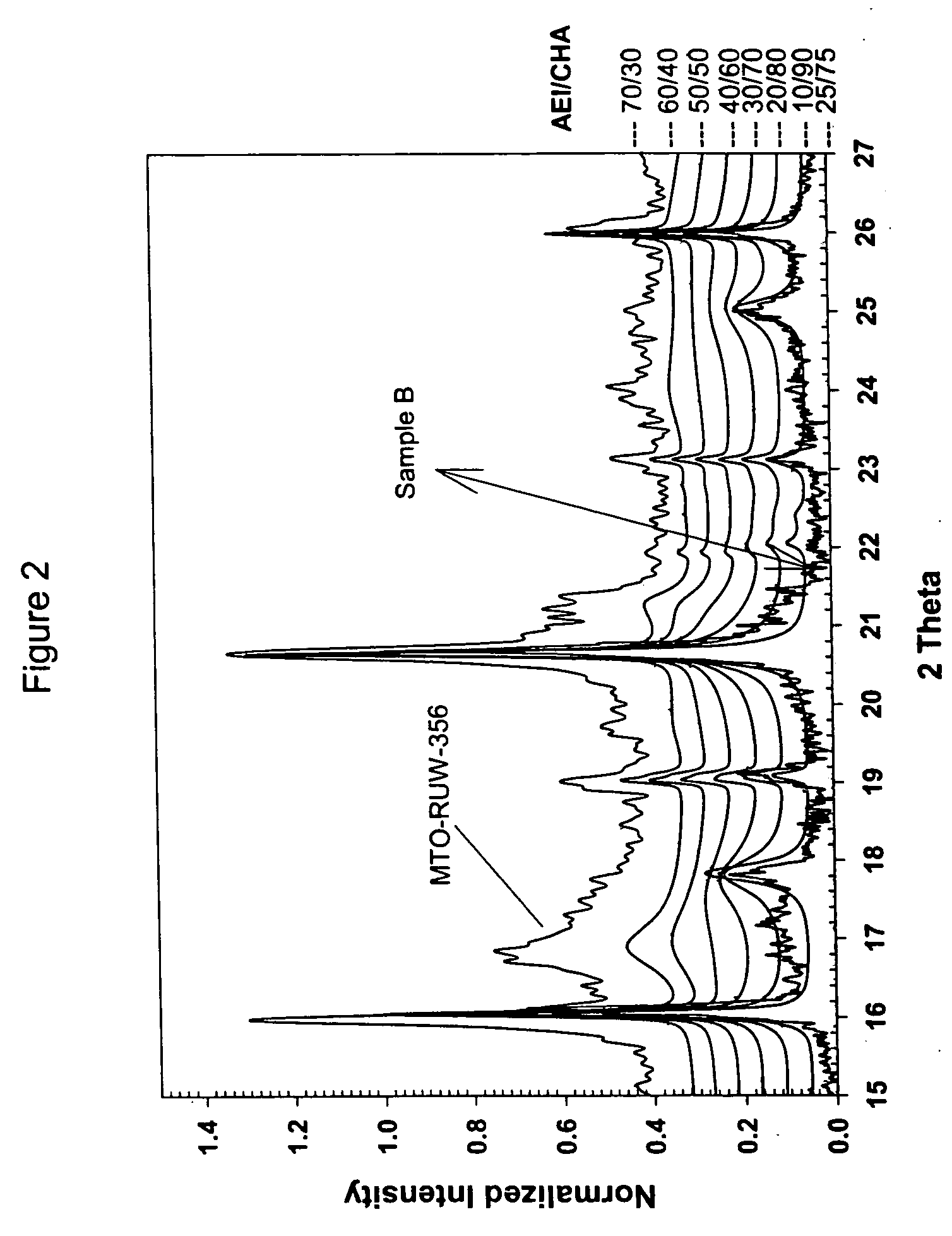Silicoaluminophosphate molecular sieve
a technology of silicoaluminophosphate and molecular sieve, which is applied in the direction of hydrocarbon preparation, hydrocarbon oil treatment, liquid hydrocarbon mixture production, etc., can solve the problems of deactivation of catalyst, clogging of cage, and adding additional cost to the conversion process of methanol to olefin by propylene, etc., and achieve good catalytic performance
- Summary
- Abstract
- Description
- Claims
- Application Information
AI Technical Summary
Benefits of technology
Problems solved by technology
Method used
Image
Examples
example 1
[0077] A solution of 33.55 gr of phosphoric acid (85% in water), 32.13 gr of de-mineralized water, and 61.4 gr of a TEAOH solution (35% in water) was prepared in a glass beaker. To this solution were added 3.32 gr of Ludox AS 40 (40% silica). 19.85 gr of alumina (Condea Pural SB) were added and a slurry was obtained with the following composition expressed as molar ratios:
0.15 SiO2 / P2O5 / Al2O3 / TEAOH / 35 H2O
This slurry was mixed until homogeneous and transferred to a 150 ml stainless steel autoclave. This autoclave was mounted on a rotating axis in an oven. The axis was rotated at 60 rpm and the oven was heated in 8 hours to 175° C. The autoclave was kept at this temperature for 48 hours. After cooling to room temperature, a sample was taken and washed and dried. An X-ray diffraction pattern was obtained. According to DIFFaX analysis, the AEI / CHA ratio was 15 / 85 (AEI / CHA=0.18). The silica to alumina molar ratio (SiO2 / Al2O3) was 0.15. The sample is hereinafter identified as Sample A.
example 2
[0078] 67.51 gr of phosphoric acid (85% in water, available from Aldrich) were diluted with 67.29 gr of demineralized water. To this solution were added 123.33 gr of a tetraethylammonium hydroxide solution (35% in water, available from Eastern). Then 2.23 gr of Ludox AS 40 (40% silica from Dupont) were added to this solution. Finally 39.84 gr of alumina (Condea Pural SB) were added and a slurry was obtained. The compositon of the mixture can be expressed with the following molar ratios:
0.05SiO2 / P2O5 / Al2O3 / TEAOH / 35 H2O.
This slurry was mixed until homogeneous and transferred to a 150 ml stainless steel autoclave. This autoclave was mounted on a rotating axis in an oven. The axis was rotated at 60 rpm and the oven was heated in 8 hours to 175 C. The autoclave was kept at this temperature for 48 hours. After cooling to room temperature, a sample was taken and washed and dried and an X-ray diffraction pattern was taken. According to DIFFaX analysis the AEI / CHA ratio was 25 / 75 (AEI / CHA=0...
example 3
[0081] A solution of 191.23 gr of phosphoric acid (85% in water from Aldrich) and 214.25 gr of de-mineralized water was mixed in a mixing bowl. To this solution 348.71 gr of a tetraethylammonium hydroxide solution (35% in water, Sachem) were added with a burette. After the mixture was homogeneous, 6.04 gr of Ludox AS 40 (40% silica from Dupont) were added. Then 122.33 gr of alumina (Condea Pural SB) were added and the mixture was stirred for 15 minutes. Then 163.46 gr of a tetraethylammonium hydroxide solution (35% in water) were added and 10.13 gr of de-mineralized water. A slurry was obtained with the following composition expressed as molar ratios:
0.045 SiO2 / 0.92 P2O5 / Al2O3 / 1.35 TEAOH / 41 H2O
This slurry was mixed until homogeneous and transferred to a 1L PARR autoclave. stainless steel autoclave and the mixture was stirred at 600 rpm during the whole hydrothermal treatment. The autoclave was heated in 5 hours to 175° C. The autoclave was kept at this temperature for 72 hours. Aft...
PUM
| Property | Measurement | Unit |
|---|---|---|
| molar ratio | aaaaa | aaaaa |
| molar ratio | aaaaa | aaaaa |
| molar ratio | aaaaa | aaaaa |
Abstract
Description
Claims
Application Information
 Login to View More
Login to View More - R&D
- Intellectual Property
- Life Sciences
- Materials
- Tech Scout
- Unparalleled Data Quality
- Higher Quality Content
- 60% Fewer Hallucinations
Browse by: Latest US Patents, China's latest patents, Technical Efficacy Thesaurus, Application Domain, Technology Topic, Popular Technical Reports.
© 2025 PatSnap. All rights reserved.Legal|Privacy policy|Modern Slavery Act Transparency Statement|Sitemap|About US| Contact US: help@patsnap.com



